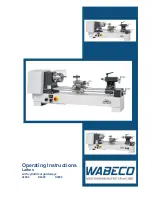
Malfunctions
Version 1.0.2 - 2020-07-20
94
Translation of original instruction
TM3310 | TM3310D
EN
T
M
3310_
GB_6
.f
m
8
Malfunctions
Malfunction
Cause/
possible effects
Solution
Machine does not turn on
•
Position switch lathe chuck protection
switches the machine off.
•
Position switch protection cover head-
stock machine switches off
•
Emergency-stop switch activated
•
Motor protection switch has triggered
by overloading.
•
Check position switch lathe chuck pro-
tection, adjust
•
Check or adjust the position switch of
protective cover headstock.
•
Unlock the emergency-stop switch
•
Avoid overloading. Activate the motor
circuit breaker again.
Power failure, Restoring readi-
Motor is hot
Motor has no power
•
Machine connected incorrectly
•
Electric three-phase connection
Feed will stop
•
Clutch of the longitudinal feed or cross
feed will slip.
•
Cutting force too high
•
If necessary, check clutch and read-
just.
Surface of workpiece too rough
•
Lathe tool blunt
•
Lathe tool springs
•
Feed too high
•
Radius at lathe tool tip too small
•
Resharpen lathe tool
•
Clamp lathe tool with less overhang
•
Reduce feed
•
Increase radius
Flat belt slips through
•
Flat belt defective, wear down
•
Tension is too loose
•
Spindle drive V-belt on page 61
Speed of rotation varies too
much
Workpiece becomes conical
•
Centre are not aligned (tailstock off-
set)
•
Top slide is not exactly set to zero
(when turning with the top slide)
•
Align the tailstock to the center
•
Align the top slide exactly
Lathe rattles
•
Feed too high
•
Spindle bearings have too much cle-
arance.
•
Reduce feed
•
Readjust spindle bearings.
Centering point runs hot
•
Workpiece has expanded
•
Loosen tailstock center
Lathe tool has a short service
life
•
Cutting speed too high
•
For large infeed
•
Insufficient cooling
•
Reduce cutting speed
•
Lower delivery / finishing stock allo-
wance not over 0.5 mm)
•
More cooling
Flank wear too high
•
Clearance angle too small (lathe tool
"pushes")
•
Lathe tool tip not adjusted to centre
height
•
Increase clearance angle
•
Correct height adjustment of the lathe
tool
Cutting edge breaks off
•
Wedge angle too small (heat buildup)
•
Grinding cracks due to improper coo-
ling
•
Excessive play in the spindle bea-
rings (oscillations occur)
•
Set greater wedge angle
•
Cool uniformly
•
Have the clearance in the spindle bea-
ring arrangement re-adjusted



























